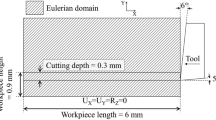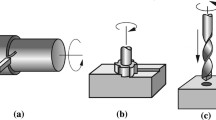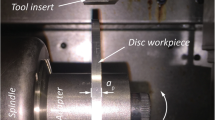Abstract
This article proposes an improved numerical model based on the coupled Eulerian-Lagrangian (CEL) formulation for the numerical analysis of metal cutting. Preliminary calculation results show that the model overcomes some shortcomings of traditional finite element (FE) models, for example, the mesh distortion and the limitation of the separation line method in the Lagrangian approach and setting the chip shape in advance in the Eulerian approach. Therefore, application of this model can provide a convenient simulation for stable and unstable cutting processes of metals and a vivid demonstration for the streamline field of plastic flow of a workpiece material during cutting. Moreover, it can accurately characterize the evolutions of stress, strain, and temperature fields in the chip, the variation histories of the cutting force with time and the shear-localized instability behaviors in the serrated chip. The simulation results have sufficiently demonstrated the potential of applying the CEL model to the numerical analysis of metal cutting. In particular, the CEL model facilitates the simulations of some special cutting processes, such as the machining of a vibrating workpiece and a thin wall component.





















Similar content being viewed by others
References
Arrazola PJ, Ozel T, Umbrello D, Davies M, Jawahir IS (2013) Recent advances in modelling of metal machining processes. CIRP Annals-Manufacturing Technology 62:695–718
Recht FR (1964) Catastrophic thermoplastic shear. Trans ASME J Applied Mechanics 31:189
Komanduri R, Hou ZB (2002) On thermoplastic shear instability in the machining of a titanium alloy. Metall Mater Trans A 33A:2995–3010
Burns TJ, Davies MA (1997) Nonlinear dynamics model for chip segmentation in machining. Phys Rev Lett 79:447–450
Molinari A, Musquar C, Sutter G (2002) Adiabatic shear banding in high speed machining of Ti–6Al–4 V: experiments and modeling. Int J Plast 18:443–459
Shaw MC, Janakiram M, Vyas A (1991) The role of fracture in metal cutting Chip formation. SME, NSF Grantees Conference, Austin, Texas:359–366
Obikawa T, Usui E (1996) Computational machining of titanium alloy–finite element modeling and a few results. ASME Journal of Manufacturing Science and Engineering 118:208–215
Poulachon G, Moisan A (1998) A contribution to the study of the cutting mechanisms during high speed machining of hardened steel. CIRP Ann 47-1:73–76
Barry J, Byrne G (2002) The mechanisms of chip formation in machining hardened steels. J Manuf Sci Eng 124:528–535
Atkins T (2003) Modelling metal cutting using modern ductile fracture mechanics: quantitative explanations for some longstanding problems. Int J Mech Sci 45:373–396
Shivpuri R, Hua J, Mittal P, Srivastava A (2002) Microstructure–mechanics interactions in modeling Chip segmentation during titanium machining. CIRP Ann Manuf Technol 51(1):71–74
Liyao G, Minjie W, Chunzheng D (2013) On adiabatic shear localized fracture during serrated chip evolution in high speed machining of hardened AISI 1045 steel. Int J Mech Sci 75:288–298
Cueto E, Chinesta F (2015) Meshless methods for the simulation of material forming. Int J Mater Form 8(1):25–43
Yao X, Bermingham M, Wang G, Dargusch M (2014) SPH/FE modeling of cutting force and chip formation during thermally assisted machining of Ti6Al4V alloy. Comput Mater Sci 84:188–197
Calamaz M, Coupard D, Girot F (2008) A new material model for 2D numerical simulation of serrated chip formation when machining titanium alloy Ti–6Al–4 V. International Journal of Machine Tools & Manufacture 48:275–288
Uhlmann E, Gerstenberger R, von der Schulenburg GM, Kuhnert J, Mattes A (2009) The finite-pointset-method for the meshfree numerical simulation of chip formation. Proceedings of the 12th CIRP Conference on Modelling of Machining Operations. 1: 145–151
Chinesta F, Lorong P, Ryckelynck D, Martinez MA, Cueto E, Doblare M, Coffignal G, Touratier M, Yvonnet J (2004) Thermomechanical cutting model Discretiation: Eulerian or Lagrangian, mesh or meshless? Int J Form Process 7(1–2):83–97
Illoul L, Lorong P (2011) On some aspects of the CNEM implementation in 3D in order to simulate high speed machining or shearing. Comput Struct 89:940–958
Al-Athel KS, Gadala MS (2011) The use of volume of solid (VOS) approach in simulating metal cutting with chamfered and blunt tools. Int J Mech Sci 53:23–30
Cheng C, Mahnken R (2015) A multi-mechanism model for cutting simulations based on the concept of generalized stresses. Comput Mater Sci 100:144–158
Molinari A, Soldani X, Miguélez MH (2013) Adiabatic shear banding and scaling laws in chip formation with application to cutting of Ti–6Al–4 V. Journal of the Mechanics and Physics of Solids 61:2331–2359
Ma W, Li XW, Dai LH, Ling Z (2012) Instability criterion of materials in combined stress states and its application to orthogonal cutting process. Int J Plast 30-31:18–40
Rosa PAR, Martins PAF, Atkins AG (2007) Revisiting the fundamentals of metal cutting by means of finite elements and ductile fracture mechanics. Int J Mach Tools Manuf 47:607–617
Pantale O, Bacaria J-L, Dalverny O, Rakotomalala R, Caperaa S (2004) 2D and 3D numerical models of metal cutting with damage effects. Comput Methods Appl Mech Eng 193:4383–4399
Huang JM, Black JT (1996) An evaluation of chip separation criteria for the FEM simulation of machining. J Manuf Sci Eng 118:545–554
Sekhon GS, Chenot JL (1993) Numerical simulation of continuous chip formation during non-steady orthogonal cutting. Eng Comput 10:31–48
Madhavan V, Chandrasekar S, Farris TN (1993) Mechanistic model of machining as an indentation process, in: DA Stephenson, Stevenson R (eds). Materials issues in machining III and the physics of machining process. The Mineral, Metals and Materials Society. 2: 187–209
Umbrello D (2008) Finite element simulation of conventional and high speed machining of Ti6Al4V alloy. J Mater Process Technol 196(1):79–87
Hashemi J, Tseng A, Chou PC (1994) Finite element modeling of segmental Chip formation in high-speed orthogonal cutting. J Mater Eng Perform 3:712–721
Warnecke G, Oh JD (2002) A new thermo-viscoplastic material model for finite-element- analysis of the Chip formation process. CIRP Annals-Manufacturing Technology. 51(1):79–82
Kim KW, Sin H-C (1996) Development of a thermo-viscoplastic cutting model using ®nite element method. Int J Mach Tools Manuf 36:379–397
Ducobu F, Rivière-Lorphèvre E, Filippi E (2014) Numerical contribution to the comprehension of saw-toothed Ti6Al4V chip formation in orthogonal cutting. Int J Mech Sci 81:77–87
Olovsson L, Nilsson L, Simonsson K (1999) An ALE formulation for the solution of two- dimensional metal cutting problems. Comput Struct 72:497–507
Movahhedy M, Gadala MS, Altintas Y (2000) Simulation of the orthogonal metal cutting process using an arbitrary Lagrangian–Eulerian finite-element method. J Mater Process Technol 103:267–275
Bayoumi HN, Gadala MS (2004) A complete finite element treatment for the fully coupled implicit ALE formulation. Comput Mech 33:435–452
Movahhedy MR, Altintas Y, Gadala MS (2002) Numerical analysis of metal cutting with chamfered and blunt tools. J Manuf Sci Eng 124:178–188
Benson DJ, Okazawa S (2004) Recent trends in ALE formulation and its applications in solid mechanics Comput. Methods Appl Mech Engrg 193:4277–4298
Xiangyu C, Fei, S, Wei, MW (2016) Numerical simulation of metal vibration cutting. Proceeding of the 12th National Academic Conference on the Impacting Dynamics. Oct. 21–25, 2015, 138–141. Ningbo, China. Also, Transaction of Beijing Institute of Technology. 36: 199–203 (In Chinese)
Bil H, Kilic SE, Tekkaya AE (2004) A comparison of orthogonal cutting data from experiments with three different finite element models. Int J Mach Tools Manuf 44:933–944
Ducobu F, Rivière-Lorphèvre E, Filippi E (2016) Application of the coupled Eulerian-Lagrangian (CEL) method to the modeling of orthogonal cutting. European Journal of Mechanics-A/Solids 59:58–66
Johnson GR, Cook WH (1983) A constitutive model and data for metals subjected to large strains, high strain rates and high temperatures. In: Proceedings of the Seventh International Symposium on Ballistics. 541
Drucker DC, Ekstein H (1950) A dimensional analysis of metal cutting. J Appl Phys 21:104
Oxley PLB (1989) The mechanics of machining: an analytical approach to assessing machinability. Halsted Press: a division of John Wiley and Sons Limited, New York
Burns TJ, Davies MA (2002) On repeated adiabatic shear band formation during high-speed machining. Int J Plast 18:487–506
Sima M, Özel T (2010) International Journal of Machine Tools & Manufacture. 50: 943–960
Seo S, Min O, Yang H (2005) Constitutive equation for Ti–6Al–4 V at high temperatures measured using the SHPB technique. International Journal of Impact Engineering 31:735–754
Lee S, Lin CF (1998) High-temperature deformation behavior of Ti6Al4V alloy evaluated by high strain-rate compression tests. J Mater Process Technol 75:127–136
Ozel T, Altan T (2000) Determination of workpiece flow stress and friction at the chip-tool contact for high-speed cutting. Int J Mach Tools Manuf 40:133–152
Atkins T (2015) Prediction of sticking and sliding lengths on the rake faces of tools using cutting forces. Int J Mech Sci 91:33–45
Zorev NN (1963) Inter-relationship between shear processes occurring along tool face and shear plane in metal cutting. Int Res Prod Eng. New York: ASME 42:9
Bahi S, List G, Sutter G (2015) Analysis of adhered contacts and boundary conditions of the secondary shear zone. Wear 330-331:608–617
Wu DW, Lin CR (1985) An analytical model of cutting dynamics. Part 1: model building. Trans ASME J Eng Ind 107:107–111
Hortig C, Svendsen B (2007) Simulation of chip formation during high-speed cutting. J Mater Process Technol 186:66–76
Davies MA, Burns TJ, Evans CJ (1997) On the dynamics of chip formation in machining hard metals. Ann CIRP 46:25–30
Atlati S, Haddag B, Nouari M, Zenasni M (2011) Analysis of a new segmentation intensity ratio “SIR” to characterize the chip segmentation process in machining ductile metals. International Journal of Machine Tools & Manufacture. 51:687–700
Bäker M, Rösler J, Siemers C (2002) A finite element model of high speed metal cutting with adiabatic shearing. Comput Struct 80:495–513
Acknowledgements
The authors are grateful for financial support from the Key National Nature Science Foundation of China (Grant No. 11132011) and the National Nature Science Foundation of China (Grant No. 11572337 and 51575029).
Author information
Authors and Affiliations
Corresponding author
Ethics declarations
Funding
This study was funded by the Key National Nature Science Foundation of China (grant number 11132011) and the National Nature Science Foundation of China (grant number 11572337 and grant number 51575029).
Conflict of interest
The authors declare that they have no conflict of interest.
Electronic supplementary material
12289_2017_1341_MOESM1_ESM.avi
Video file 1. The evolution process of the equivalent plastic strain field in the cutting process with the tool chatter (AVI 2159 kb)
12289_2017_1341_MOESM2_ESM.avi
Video file 2. The evolution process of the equivalent plastic strain field in the cutting process with the large plastic deformations of structure of thin-walled components (AVI 5741 kb)
Rights and permissions
About this article
Cite this article
Shuang, F., Chen, X. & Ma, W. Numerical analysis of chip formation mechanisms in orthogonal cutting of Ti6Al4V alloy based on a CEL model. Int J Mater Form 11, 185–198 (2018). https://doi.org/10.1007/s12289-017-1341-z
Received:
Accepted:
Published:
Issue Date:
DOI: https://doi.org/10.1007/s12289-017-1341-z




